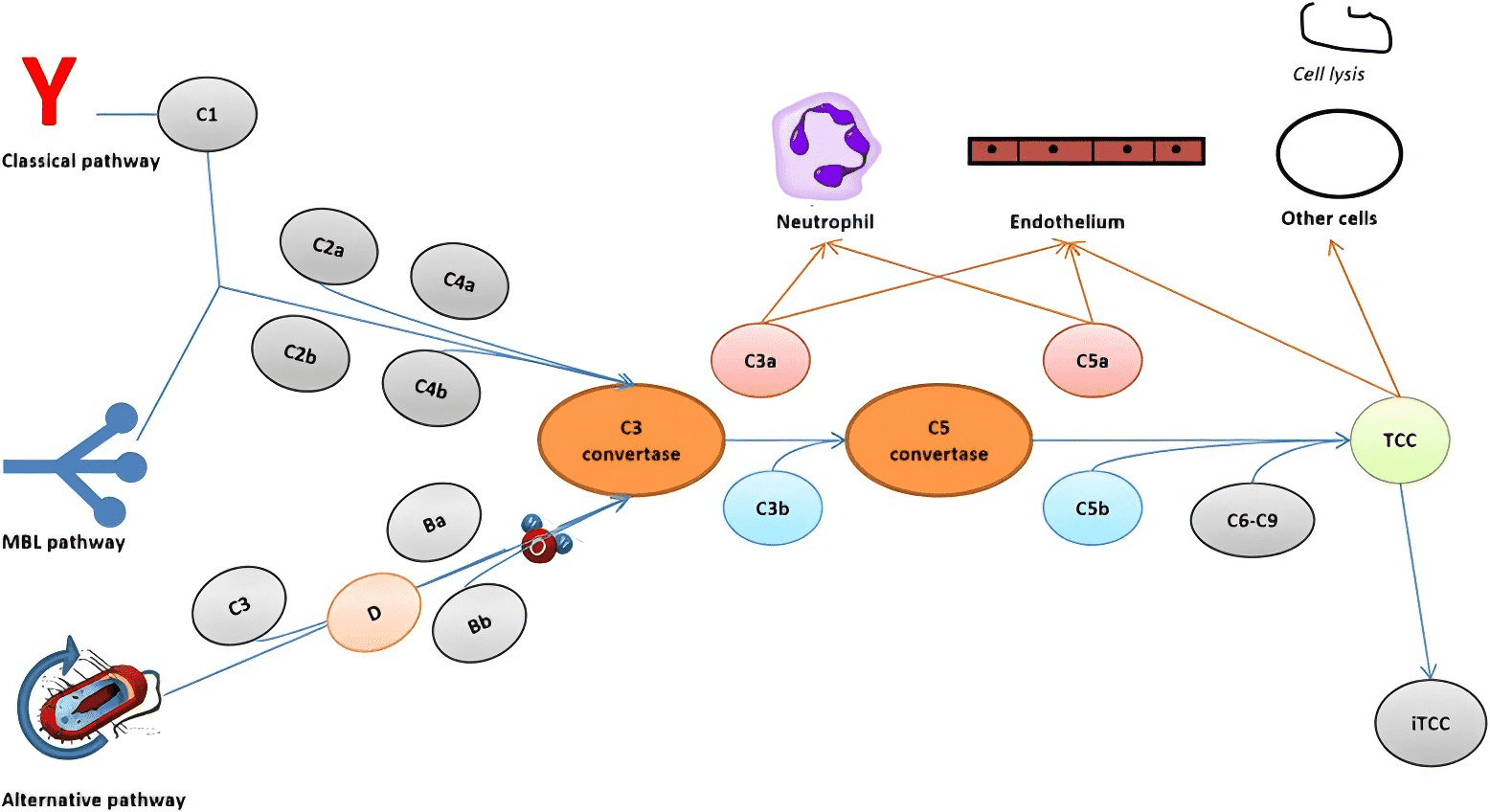The function of a complement system in innate host defense is fulfilled by three effector pathways that are lysis, inflammation, and opsonization/phagocytosis. Regardless of the pathway, complement activation converges on the generation of these effector pathways allowing the complement system to accomplish its physiological imperatives in host defense, including:
-
Direct lysis of targeted surfaces by the assembly of membrane attack complex (MAC);
-
Alerting and priming the immunity by the generation of robust proinflammatory anaphylatoxins;
-
Opsonization and clearance of target surfaces by complement opsonins (e.g. C3b, C3bi, complement factors C4b) and involvement of complement receptors (CRs) on phagocytic cells (e.g. macrophages, neutrophils).
The Mechanisms of Complement Effector in Health & Disease
Complement is an effector system that can mediate a series of biological activities in vivo and in vitro. Most familiar is the ability to modulate the lytic destruction of many kinds of cells and pathogens, including bacteria, viruses, and virus-infected cells. While frequently considered to be the effector side of immunoreactions, recent evidence indexes that the complement system also directly recognizes and is triggered by a certain number of bacteria, viruses, and virus-infected cells in the absence of antibody. In such reactions, complement implements its recognition role commonly associated with antibody molecules or immune lymphocytes. As well, the complement system may thus function as a natural surveillance system prior to the induction of specific immunity.

Fig. 1 Effectors of the complement system.1, 2
-
Role of Complement System in Opsonization
Different opsonin molecules are able to operate different functions, including complement protein-mediated opsonization, and circulating protein-mediated opsonization, and antibody-mediated opsonization.
-
Role of Complement System in Cell Lysis
The complement system works in several ways to mobilize defense mechanisms. Cell lysis is one function of the complement system, probably not the most important one, but sometimes, this causes serious disorders, such as Rh disease, immune hemolytic anemia, and so on.
-
Role of Complement System in Phagocytosis
Complement-mediated phagocytosis can be achieved by specific recognition of bound complement components by the corresponding CRs on the phagocytes. For example, opsonization by C3b targets foreign particles for phagocytosis.
-
Role of Complement System in Inflammation
The complement system is a potent constitute of the innate immune response, boosting inflammation and coordinating defense against pathogenic agents.
-
Role of Complement System in Chemotaxis
Complement complement factors C3a, complement factors C5a, and C567 all belong to chemotactic factors. For example, chemotaxis by C5a attracts and invades phagocytic cells to the sites of damage.
-
Role of Complement System in Antibody Formation
The complement system can promote antibody formation. The impacts on antibody responses may result from complement activation rather than interference with the direct participation of complement in induction.
The Methodology for Complement Activation
The engagement of the complement system in biological behaviors has been ascertained by several techniques over the years. These involve the quantitation of individual complement components in human serum and the demonstration of complement deposition in damaged tissues in human diseases and in experimental diseases in animal models. However, such techniques have limitations in sensitivity and specificity.
Today, assays that detect specific characteristics of the complement activation process have become available and affordable. These detections can be used to test the physical, chemical, and/or antigenic changes feature of the complement activation process. They are extremely specific and quantitative and furthermore, most of which are usable with samples from patients. Remarkably, there’re three general approaches that have been applied to develop and explore such specific quantitative assays for complement activation, including:
-
Firstly, tests to quantitate activation-specific limited proteolysis of the complement component;
-
Secondly, assays to detect and quantitate new antigens and other activation-specific antigenic changes;
-
Thirdly, assays to identify and quantitate the characteristic of protein-protein complexes of the activation process.
Creative Biolabs is a leading biological company that has established comprehensive one-stop services for Complement Therapeutics. If you’d like to know more details, please directly contact us and consult our technical supports online.
References
-
Ramirez, Giuseppe A., et al. "Parietal and intravascular innate mechanisms of vascular inflammation." Arthritis research & therapy 17 (2015): 1-12.
-
under Open Access license CC BY 4.0, without modification
Related Product
For Research Use Only.
Related Sections:

